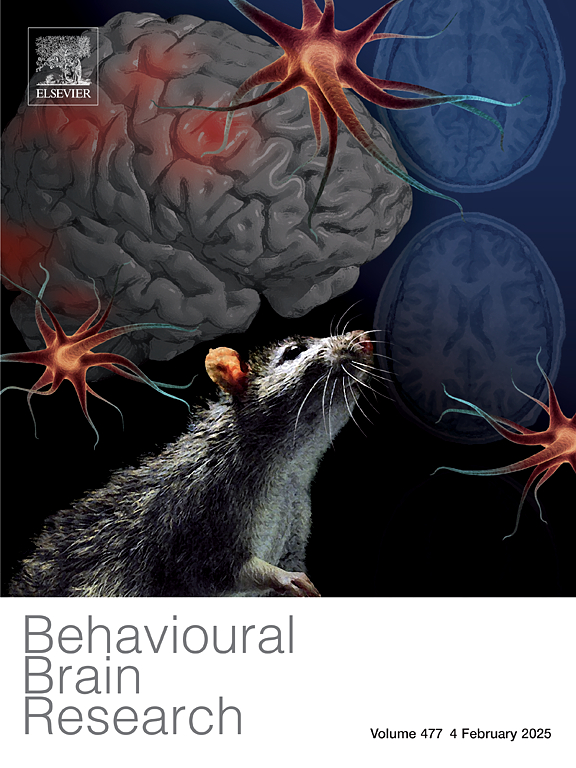肝性脑病可引起小鼠焦虑、抑郁样行为、细胞因子功能障碍、BDNF下调及神经病理改变。
IF 2.3
3区 心理学
Q2 BEHAVIORAL SCIENCES
引用次数: 0
摘要
肝性脑病(HE)患者有睡眠障碍、易怒、焦虑和抑郁症状等精神障碍的报道。然而,HE患者的这些神经精神障碍在很大程度上仍然未知。本研究旨在探讨急性HE是否会导致小鼠的焦虑和抑郁样行为,以及前额皮质、纹状体和海马中炎症细胞因子、趋化因子和神经营养水平的改变以及神经病理改变。腹腔注射单剂量硫乙酰胺(TAA) 600mg/kg诱导HE。行为症状通过野外、高架迷宫和强迫游泳测试进行评估。测量细胞因子[肿瘤坏死因子(TNF)、干扰素γ (IFN-γ)、白细胞介素6 (IL-6)、白细胞介素10 (IL-10)、白细胞介素12p70 (il - 12p70)、白细胞介素1- β (IL-1β)]、趋化因子[趋化因子(C-C基序)配体2 (CCL2)、趋化因子(C-X-C基序)配体1 (CXCL1)、C-X3-C基序趋化因子配体1 (CX3CL1)]和神经营养因子[脑源性神经营养因子(BDNF)、胶质细胞系源性神经营养因子(GDNF)、神经生长因子(NGF)],CBA和ELISA法检测纹状体和海马。通过血清肝酶和组织病理学分析评估肝功能障碍和损伤。我们评估了不同脑区GFAP和Iba-1的免疫组化。TAA诱导肝坏死、炎症,提高血清肝酶水平和髓过氧化物酶(MPO)、n -乙酰氨基葡萄糖酶(NAG)活性。诱导后7天,HE小鼠出现焦虑和抑郁样行为,并在大脑皮层和海马区表现出星形胶质细胞和反应性小胶质细胞。此外,HE动物在前额皮质中显示较低水平的BDNF和较高浓度的IL-1β,海马中较低水平的IFN-γ和IL-6。我们的数据首次揭示了急性肝性脑病引起小鼠焦虑和抑郁样行为、细胞因子功能障碍、BDNF下调和神经病理改变。本文章由计算机程序翻译,如有差异,请以英文原文为准。
Hepatic encephalopathy induces anxiety and depression-like behaviors, cytokine dysfunction, BDNF down-regulation and neuropathological changes in mice
Psychiatric disorders, such as disturbance of sleep, irritability, anxiety and depressive symptoms have been reported in patients with hepatic encephalopathy (HE). However, these neuropsychiatric disorders in patients with HE remains largely unknown. The present study aimed to explore if acute HE lead to anxiety and depression-like behaviors and alterations in the levels of inflammatory cytokines, chemokines and neurotrophic levels in the pre-frontal cortex, striatum and hippocampus as well as neuropathological changes in mice. HE was induced by an intraperitoneal single dose of 600 mg/kg of thioacetamide (TAA). Behavioral symptoms were assessed by open field, elevated plus maze and forced swimming tests. Measurements of cytokines [tumor necrosis factor (TNF), interferon-gamma (IFN-γ), interleukin 6 (IL-6), interleukin 10 (IL-10), interleukin 12p70 (IL-12 p70), interleukin-1-beta (IL-1β)], chemokines [chemokine (C-C motif) ligand 2 (CCL2), chemokine (C-X-C motif) ligand 1 (CXCL1), C-X3-C motif chemokine ligand 1 (CX3CL1)] and neurotrophic factors [brain-derived neurotrophic factor (BDNF), glial cell line derived neurotrophic factor (GDNF), nerve growth factor (NGF)] from pre-frontal cortex, striatum and hippocampus were obtained by CBA and ELISA assays. Liver dysfunction and injury were evaluated by serum liver enzymes and histopathological analysis. We evaluated immunohistochemistry for GFAP and Iba-1 at different brain regions. TAA induced liver necrosis, inflammation and increased serum levels of liver enzymes and myeloperoxidase (MPO), N-acetylglucosaminidase (NAG) activities. Seven days post induction, mice with HE developed anxiety and depression-like behaviors and exhibited areas of astrogliosis and reactive microglia in the cerebral cortex and hippocampus. Additionally, HE animals showed lower levels of BDNF and higher concentrations of IL-1β in the pre-frontal cortex and lower levels of IFN-γ and IL-6 in the hippocampus. Our data revealed for the first time that acute hepatic encephalopathy causes anxiety and depression-like behaviors, cytokine dysfunction, BDNF down-regulation and neuropathological changes in mice.
求助全文
通过发布文献求助,成功后即可免费获取论文全文。
去求助
来源期刊

Behavioural Brain Research
医学-行为科学
CiteScore
5.60
自引率
0.00%
发文量
383
审稿时长
61 days
期刊介绍:
Behavioural Brain Research is an international, interdisciplinary journal dedicated to the publication of articles in the field of behavioural neuroscience, broadly defined. Contributions from the entire range of disciplines that comprise the neurosciences, behavioural sciences or cognitive sciences are appropriate, as long as the goal is to delineate the neural mechanisms underlying behaviour. Thus, studies may range from neurophysiological, neuroanatomical, neurochemical or neuropharmacological analysis of brain-behaviour relations, including the use of molecular genetic or behavioural genetic approaches, to studies that involve the use of brain imaging techniques, to neuroethological studies. Reports of original research, of major methodological advances, or of novel conceptual approaches are all encouraged. The journal will also consider critical reviews on selected topics.
 求助内容:
求助内容: 应助结果提醒方式:
应助结果提醒方式:


